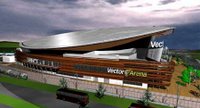 With the prompting of a recent drive-by. and a post by TinCanMan, I thought I'd re-acquaint myself with Auckland's $80million Vector Arena, according to the Auckland City Council website "a world-class, multi-functional indoor arena that seats up to 12,000 people . . . being built at Quay Park in downtown Auckland" in a public-private partnership which will is costing ratepayers the princely sum of 68 of those 80 million dollars.
With the prompting of a recent drive-by. and a post by TinCanMan, I thought I'd re-acquaint myself with Auckland's $80million Vector Arena, according to the Auckland City Council website "a world-class, multi-functional indoor arena that seats up to 12,000 people . . . being built at Quay Park in downtown Auckland" in a public-private partnership which will is costing ratepayers the princely sum of 68 of those 80 million dollars.Amongst the things that struck me about the Arena project was both the prospect of seeing undercover ice hockey on Auckland's waterfront -- who amongst you could fail to be excited by that? -- and the history of the project. This was a project conceived way back in 1996, and is due to be completed ten years later in 2006. Ten years! And unlike Auckland's Ayatollah Centre project, and the more recent Britomart project, both of which took many, many years to traverse their fraught paths -- and many years in which whole city precincts were shut down so that each white elephant could be erected -- the Arena project has travelled relatively smoothly and promises more value for the effort involved. But it still took ten years from conception to erection: we might perhaps view that as a benchmark time scale for a large public project done under the auspices of local government when all goes well.
How does that compare with other recent high profile public projects? Badly. Aside from the many restrictions and delays imposed on them by meddling local governments, private projects generally proceed in a fairly short and straight line rather than the long, complex and often pretzel-shaped path that council projects frequently traverse.
- The St Lukes Shopping Centre was made over totally in a project worth $55 million in just two years, and without the welter of disruptions and closures attendant on the Britomart project (unlike council, private developers can't afford to piss off retailers in and around their developments).
 The first stage of the enormous $538 million Sylvia Park shopping centre -- New Zealand's largest -- will open for business in August 2006. Including the time it took for the various councils to give the project the go-ahead and to include the possibility of such a thing in their various district plans and 'growth strategies,' the first stage of the complex will have been completed without undue fuss and bother in just ten years. (Bob Dey has summary of the site's history at the bottom of this page.)
The first stage of the enormous $538 million Sylvia Park shopping centre -- New Zealand's largest -- will open for business in August 2006. Including the time it took for the various councils to give the project the go-ahead and to include the possibility of such a thing in their various district plans and 'growth strategies,' the first stage of the complex will have been completed without undue fuss and bother in just ten years. (Bob Dey has summary of the site's history at the bottom of this page.) - And the $60million purpose-built Sky City Convention Centre (right) was conceived, designed and built in just three years (and probably making an enormous profit in a few more) all while council were scratching their heads, staring at their navels and wondering if a convention centre might not be a bad thing for a mayor to put his name to.
5 comments:
The Greens were partly right about this - these ventures transfer risk of losing money to the public sector and making money to the private sector. However one successful example is the Melbourne Citylink toll road- but that was almost entirely private - one public component was that Transurban was allowed to take over running parts of publicly owned freeways that connect the tollroad, and to toll them. It had to buy the land, choose the route, buy the tolling system and run it. The tolls are regulated and the road transfers to state ownership after 35 years (which could be reversed) but it is a good example of a private road for now. Most Sydney toll roads are the same, and there is no reason why they can't always be private!
This was one of the first "BOOT" schemes, where risk is passed to private company - with Council getting ownership back in 30 years - a lot of effort was in finding right owner (one fell over during the process). day to day risks rests with operator - keeps council beaurcrats out of it! - got to be good?!
Anonymous: is BOOT an acronmym? I've never heard of this term.
I'm sorry. I'll read that again.
How about 'acronym' instead!
BOOT = Build, Own, Operate, Transfer. It's explained at the Council site linked from the article, Sus.
Post a Comment